Culinary Masterclass 2 - Eclairs
Due to popular demand this last class in the course is going to be eclairs.
Choux pastry, of which eclairs are made, is quite unusual in being double-cooked: (Except for the addition of eggs, hot water crust pastry uses a similar double-cooking technique to give the dough enough strength to hold a pie shape for baking without needing a tin.)
Choux pastry, of which eclairs are made, is quite unusual in being double-cooked: (Except for the addition of eggs, hot water crust pastry uses a similar double-cooking technique to give the dough enough strength to hold a pie shape for baking without needing a tin.)
- First when the mixture is prepared by beating flour into hot liquid to make a thickened roux, or panade.
- Second when it is baked after being blended with eggs, which puffs up the pastry so it looks a bit like a choux (French for cabbage) but still holds its shape as it then hardens and browns due to the elasticity of the dough and the setting quality of the eggs.
menu
Shoo, pastry. Get outta here!
Eclairs
Eclairs
Filled and glazed just how you like them.
Profiteroles
Basically, just miniature eclairs.
Potential Fillings:
Whipped CreamPretty much what it says on the tin. Without added sugar or flavourings.
Crème Chantilly
Crème Chantilly is simply a sweetened cream made by beating sugar (typically confectioner's) or sugar syrup into thickened cream. It sometimes includes vanilla for extra flavour.
Despite the fact that you might think no origin story is required for such a simple idea, legend has it that this delicious sweetened whipped cream was invented in 1671 by chef Francois Vatel as part of an extravagant banquet he prepared for Louis XIV at the Chateau de Chantilly.
Crème Anglaise
Known in English as custard, it's more fluid than the whipped creams and forms the basis of many ice creams, mousses, crème brülée, and île flottante (floating islands). It is made by heating sweetened milk or cream and thickening them with egg yolks.
Which is why it is also sometimes known as surprise scrambled eggs.
Crème Pâtissière
Or Pastry Cream is a thicker custard often used to fill éclairs, profiteroles and other classic pastries. It is made by heating milk, sugar, egg, flour or cornflour to create a thick consistency. Butter is added at the end for flavour.
Combination Creams:
Crème Mousseline
Crème Mousseline combines crème Pâtissière and whipped, softened butter for a lighter, more delicate texture. It is often used when the cream needs to hold up when a pastry is cut, for example in mille feuille.
Crème Diplomat
Crème Diplomat is made by adding Whipped Cream or Crème Chantilly and (optionally) gelatin to Crème Pâtissière. This creates a light, stable cream that can be used in moulds or as a pastry filling.
Crème Chiboust
Also known as crème St-Honore after the dessert it was invented for, Crème Chiboust combines Crème Pâtissière and whipped egg whites. Gelatin may be added to provide extra stability.
Bavarois
Bavarois, Bavarian cream or Crème Bavaroise, has a Crème Anglaise base with added whipped cream and gelatin. It can be served as a moulded dessert or as a filling for tarts, cakes or charlottes.
Crémeux
Cremeux is crème Anglaise thickened with butter and sometimes gelatin. It is often flavoured with fruit puree, chocolate or caramel and used as a tart filling.
Any of these can be combined with vanilla, citrus fruit zest, caramel, ganache which Aaron insists should be made with butter, though presumably not just butter!, coffee, cocoa, crushed biscuits like Lotus Biscoff, liquors, chipped or grated chocolate. Or absolutely anything else you might fancy. Go wild!
Eclairs
sweet
Aaron was emphatic about using water and never milk as the dough's liquid component, but I understand that it is actually common to use milk, or part-milk.
The proteins and sugars in the milk will make the pastry brown more rapidly during the baking, so you should bear that in mind.
The (original BBC) recipe calls for lightly salted butter - but I'm not so sure. Some of our eclairs were definitely over-salted.
The (original BBC) recipe calls for lightly salted butter - but I'm not so sure. Some of our eclairs were definitely over-salted.
Makes about 20
Ingredients
- 170g lightly salted or not butter chopped into small cubes
- 450ml water
- 200g plain flour
- 5 medium eggs, beaten
For the Filling:- Chantilly or Pastry Cream
Heat oven to 200°C/180°C fan/ Gas 6 and cut two pieces of baking parchment to fit two baking sheets.
Using a ruler and pen, mark 10 lines about 12cm long over each piece, leaving plenty of space between the lines, then flip the parchment over. If you're something of a perfectionist!
Fit a piping bag with a large round piping nozzle, about 1.5cm wide.
Put the butter in a saucepan with the water. Sieve the flour into a large bowl and set aside.
Bring the butter and water to a rolling boil, so the butter has melted, then tip in the flour and beat like mad with a wooden spoon until the mixture pulls away from the sides of the pan and is lump-free.
Tip into the bowl and spread the thick paste up the sides a little to help it cool quickly, then leave for a few minutes until cool enough to press the back of your hand on.
When the flour paste has cooled but is not cold, start adding the egg, bit by bit, beating well between each addition until you have a smooth batter which will reluctantly drop off the end of your spoon (you can do this in a freestanding mixer if you have one).
You may not need to use all the egg, so add it slowly. Transfer to your piping bag and use a little of the mixture to stick the parchment to your trays.
Pipe the choux onto the baking sheet, using the lines as a guide. Pipe slowly so the eclairs aren’t too skinny though it is possible to make them too thick! each one should be about 2.5cm wide x 12cm long. Bake for 35-40 mins, swapping the trays around for the final 10 mins. The choux should be puffed, golden and sound hollow when tapped.
(Can be made a day ahead and stored in an airtight container, reheat in the oven for 5-10 mins to crisp up before filling.)
To fill, split each eclair through the middle with a serrated knife. Alternatively bore a hole in one or both ends of the eclair and pipe your favourite filling in through the hole.
Using a ruler and pen, mark 10 lines about 12cm long over each piece, leaving plenty of space between the lines, then flip the parchment over. If you're something of a perfectionist!
Fit a piping bag with a large round piping nozzle, about 1.5cm wide.
Put the butter in a saucepan with the water. Sieve the flour into a large bowl and set aside.
Bring the butter and water to a rolling boil, so the butter has melted, then tip in the flour and beat like mad with a wooden spoon until the mixture pulls away from the sides of the pan and is lump-free.
Tip into the bowl and spread the thick paste up the sides a little to help it cool quickly, then leave for a few minutes until cool enough to press the back of your hand on.
When the flour paste has cooled but is not cold, start adding the egg, bit by bit, beating well between each addition until you have a smooth batter which will reluctantly drop off the end of your spoon (you can do this in a freestanding mixer if you have one).
You may not need to use all the egg, so add it slowly. Transfer to your piping bag and use a little of the mixture to stick the parchment to your trays.
Pipe the choux onto the baking sheet, using the lines as a guide. Pipe slowly so the eclairs aren’t too skinny though it is possible to make them too thick! each one should be about 2.5cm wide x 12cm long. Bake for 35-40 mins, swapping the trays around for the final 10 mins. The choux should be puffed, golden and sound hollow when tapped.
(Can be made a day ahead and stored in an airtight container, reheat in the oven for 5-10 mins to crisp up before filling.)
To fill, split each eclair through the middle with a serrated knife. Alternatively bore a hole in one or both ends of the eclair and pipe your favourite filling in through the hole.
Crème Pâtissière or Crème Chantilly are popular.
Glaze with caramel, or ganache and sprinkles if you like.
Easy to get wrong and end up with soggy or under-risen eclairs.
But terrific when it works!
But terrific when it works!
Crème Pâtissière
sweet ingredient
Should be more than enough filling for 20 eclairs!
Ingredients
For the Crème Pâtissière- 300ml milk
- 150ml double cream
- 3 egg yolks
- 50g white caster sugar
- 3 tbsp cornflour
Pour the milk and cream into a saucepan. Heat until just simmering, then remove from the heat.
Meanwhile, tip the egg yolks into a bowl and add the sugar and cornflour, whisking together until smooth. Pour over the milk mixture, mix, then pour back into the saucepan.
Cook over a medium heat for 5-8 mins until the crème Pâtissière thickens to a thick custard consistency.
Sieve into a jug, cover the surface with cling film and chill for at least 3 hrs, or up to 3 days.
Meanwhile, tip the egg yolks into a bowl and add the sugar and cornflour, whisking together until smooth. Pour over the milk mixture, mix, then pour back into the saucepan.
Cook over a medium heat for 5-8 mins until the crème Pâtissière thickens to a thick custard consistency.
Sieve into a jug, cover the surface with cling film and chill for at least 3 hrs, or up to 3 days.
Chantilly Cream
sweet ingredient
Aaron prefers caster sugar, rather than the more usual confectioner's (or icing) sugar for his Crème Chantilly.
Enough to fill 20 eclairs
Ingredients
For the Chantilly Cream:- 300ml double cream
- 15g caster sugar
- ½ tsp vanilla essence
Simply whip the cream with the sugar and vanilla flavour until it soft peaks.
It will need to stiff be enough to hold air, but still pipeable.
Easy Peasy. Except for the sore arm!
Incidentally, you can recover over-whipped cream (which starts to separate and go grainy) by just adding a little more cream and incorporating it back in gently.
Incidentally, you can recover over-whipped cream (which starts to separate and go grainy) by just adding a little more cream and incorporating it back in gently.
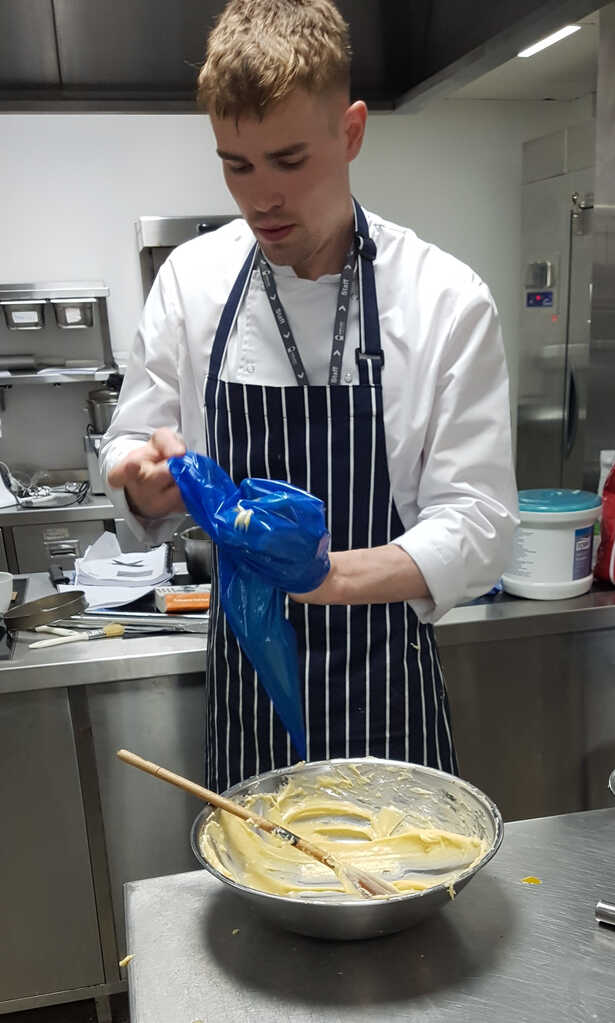

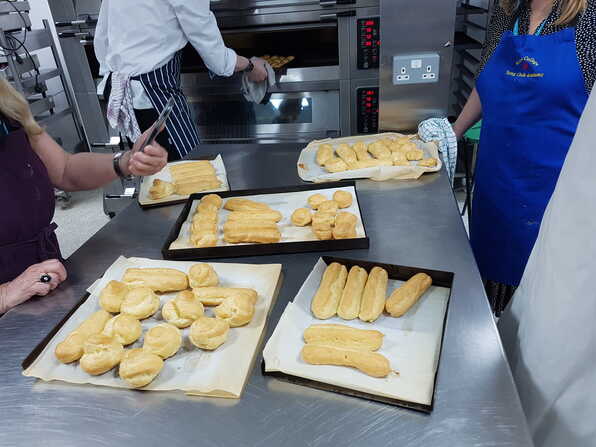
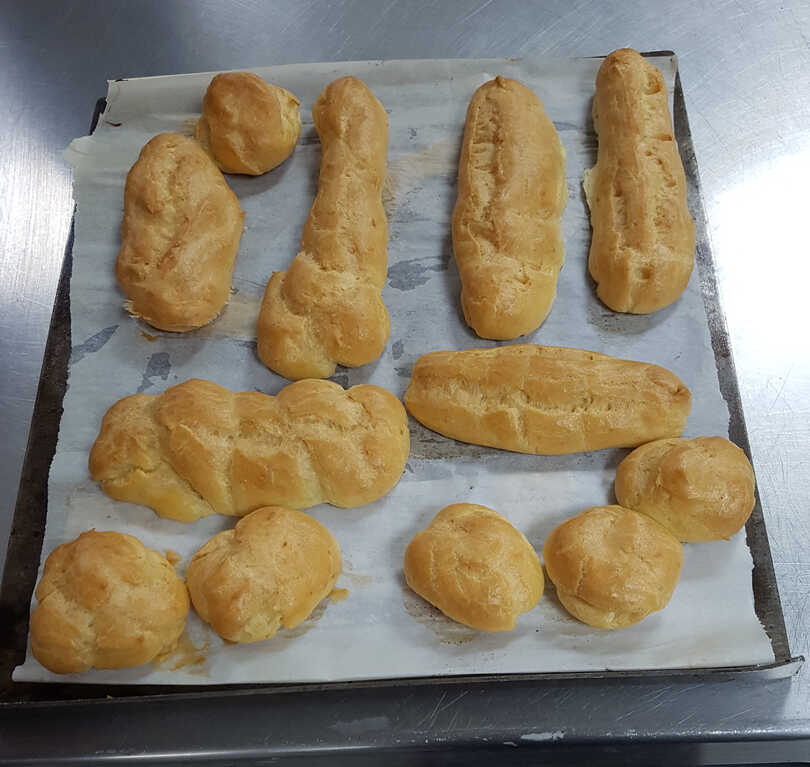

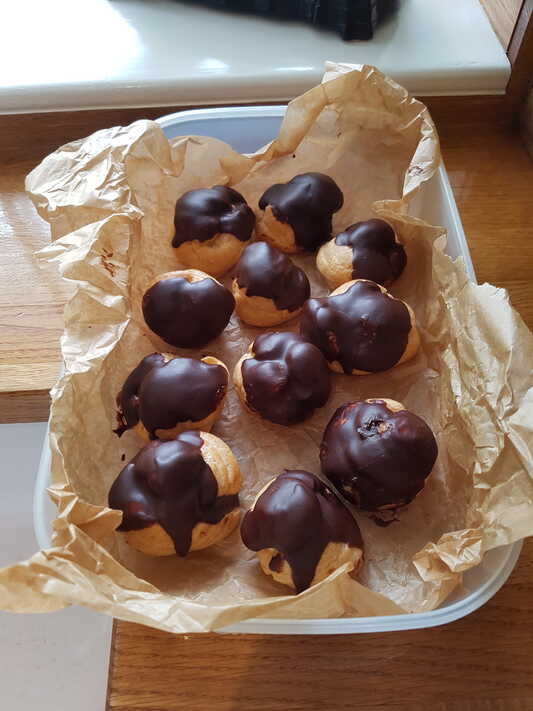

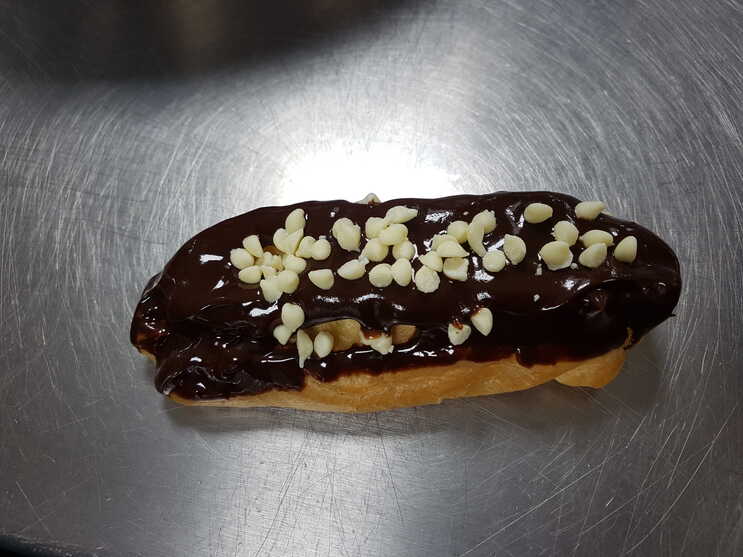
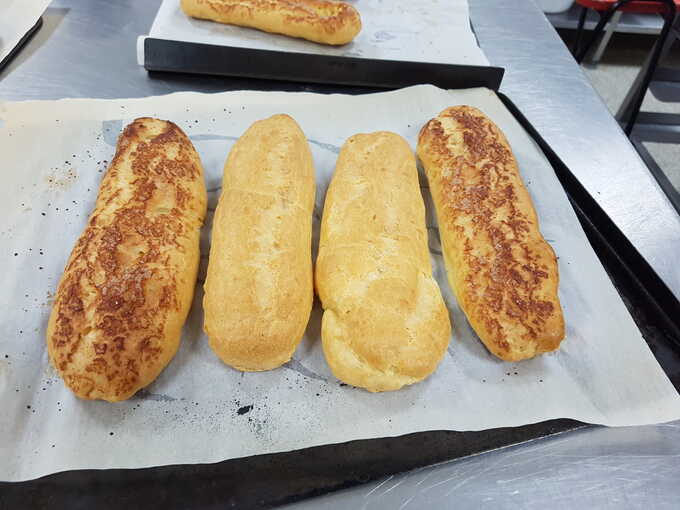
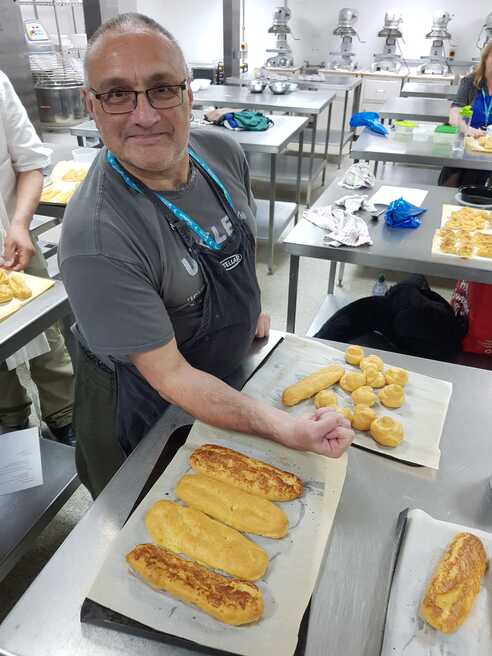
If you're making profiteroles just pipe them vertically, pumping the nozzle up and down a little to get a rounded bun shape.
Wet your finger and smooth away any trails of dough left from the piping.
You can sprinkle sugar over the eclairs before baking if you want to give them a baked-on mottled glaze appearance.